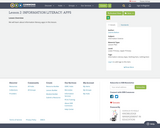
We will learn about information literacy apps in this lesson.
- Subject:
- Information Science
- Material Type:
- Lesson Plan
- Author:
- Leanne Bolton
- Date Added:
- 06/10/2018


We will learn about information literacy apps in this lesson.

نشاط تفاعلي حول المرادفات الأكثر استعمالا في اللغة الفرنسية
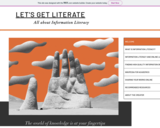
An OER which highlights the importance of information literacy in this day and age of the fourth information revolution and shares some of the tips and tricks accumulated by a distance learner at the University of the Philippines Open University.
Outline of the Content:
1. Home
2. What is Information Literacy?
3. Information Literacy and Online Learning
4. Finding High-Quality Information Online
5. Wikipedia for Academics
6. Sharing Your Works Online
7. Recommended Resources
8. About the Author

This is a seven-problem set to use to practise Python Programming Language basics by solving problems. This set has been used at Izmir Fen Lisesi (A Science High School) since 2019.

The following course will take new customer service phone team members through day one of onboarding training. These step-by-step sound bites will walk team members through:1. Logging into the appropriate applications to take calls and submit tickets2. How to answer customer phone calls and transfer to the corresponding department3. Edit customer profiles: name, email, address, and Add-Ons4. Ending a call and submitting a ticket

This open textbook for students in core Library and Information Science courses introduces students to select historical and contemporary issues in LIS. Centered on the question, “What is a library?,” the text includes explorations of norms of practice in libraries, information gathering, and professional values. This text offers students – both those who currently work in libraries and those who don’t – a foundational exploration of theoretical and ethical issues related to the field.

Module created in Canvas using DesignPlus that provides an overview of the items available from Shelton State Community College's libraries.
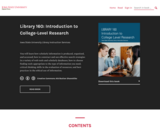
Short Description:
You will learn how scholarly information is produced, organized, and accessed; how to construct and use effective search strategies in a variety of web tools and scholarly databases; how to choose finding tools appropriate to the type of information you need; critical thinking skills in the evaluation of resources; and best practices in the ethical use of information.
Long Description:
You will learn how scholarly information is produced, organized, and accessed; how to construct and use effective search strategies in a variety of web tools and scholarly databases; how to choose finding tools appropriate to the type of information you need; critical thinking skills in the evaluation of resources; and best practices in the ethical use of information.
Word Count: 34932
Included H5P activities: 18
(Note: This resource's metadata has been created automatically by reformatting and/or combining the information that the author initially provided as part of a bulk import process.)
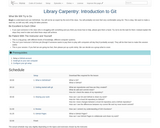
Library Carpentry lesson: An introduction to Git. What We Will Try to Do Begin to understand and use Git/GitHub. You will not be an expert by the end of the class. You will probably not even feel very comfortable using Git. This is okay. We want to make a start but, as with any skill, using Git takes practice. Be Excellent to Each Other If you spot someone in the class who is struggling with something and you think you know how to help, please give them a hand. Try not to do the task for them: instead explain the steps they need to take and what these steps will achieve. Be Patient With The Instructor and Yourself This is a big group, with different levels of knowledge, different computer systems. This isn’t your instructor’s full-time job (though if someone wants to pay them to play with computers all day they’d probably accept). They will do their best to make this session useful. This is your session. If you feel we are going too fast, then please put up a pink sticky. We can decide as a group what to cover.
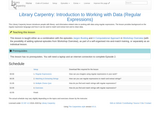
This Library Carpentry lesson introduces librarians and others to working with data. This Library Carpentry lesson introduces people with library- and information-related roles to working with data using regular expressions. The lesson provides background on the regular expression language and how it can be used to match and extract text and to clean data.

Library Carpentry lesson: an introduction to OpenRefine for Librarians This Library Carpentry lesson introduces people working in library- and information-related roles to working with data in OpenRefine. At the conclusion of the lesson you will understand what the OpenRefine software does and how to use the OpenRefine software to work with data files.
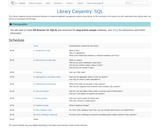
Library Carpentry, an introduction to SQL for Librarians This Library Carpentry lesson introduces librarians to relational database management system using SQLite. At the conclusion of the lesson you will: understand what SQLite does; use SQLite to summarise and link data.
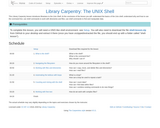
Library Carpentry lesson to learn how to use the Shell. This Library Carpentry lesson introduces librarians to the Unix Shell. At the conclusion of the lesson you will: understand the basics of the Unix shell; understand why and how to use the command line; use shell commands to work with directories and files; use shell commands to find and manipulate data.
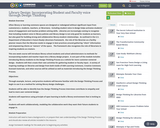
Often library or learning commons spaces are designed or redesigned without significant input from customers(i.e. students, teachers, or librarians). Including student voice in design helps activates students' sense of engagement and teaches problem solving skills. Libraries are increasingly coming to recognize that including student voice in library policies and library design is not only good for students as learners, but also good for building strong and collaborative library-student relationships. As outlined in the U.S. Department of Education's Future Ready Librarians framework, the role of the librarian as a facility planner means that the librarian needs to engage in best practices around gathering "client" information and empowering clients as "owners" of the space. The framework also recognizes the role of librarians in inspiring students as creators. This one week course will introduce library school students and school administrators to methods for incorporating student and teacher input into a library design project. A core part of the module includes introducing library students to the Design Thinking Process as a vehicle for more customer-centered design. Students will then create their own activities for gathering student or faculty input. A variety of inspiring readings on libraries and design from both inside of OER Learning Commons, Creative Commons licensed materials, and other sources will be utilized as well as materials introducing the Design Thinking Process. Objectives:Through example, lecture, and practice students will become familiar with the Design Thinking Process and begin to use it as a method for solving library design challenges.Students will be able to identify how the Design Thinking Process interviews contribute to empathy and lead to more user centered design.Students will experience using principle of open learning to build a library environment that is inviting to all.Students will work collaboratively, modeling the collaborative work they want their future students to engage in.

There are nine primary characteristics of what are considered the best library training programs. No one program fits every organization, but most training programs that are sucessful and show employees returning from them with marketable skills will have at least some of these qualities contained in them.1. Effective Management of the Training ProgramThe best programs will start with an individual who is the motivator behind the group. Irregardless of the title they hold, this is the person who organizes all the training sessions. The Training Librarian would be responsible for planning and executing all training innitiatives within the library system. the best person for the role would be someone who is innately curious, motivated, and have a vested interest in developing others' skills and to help them reach their potential within the library community. They must be committed to learning and want to help improve everyones skills, not just their own.In addition, the Training Librarian would have to market the program both internally and externally in order to make certain that people are aware of the opportunities that are available to them.2. Needs AssessmentThe Training Librarian would have to, periodically, perform an assessment of the organizational needs of both the employees and patrons/clients. Curiosity comes into play here. The Librarian must be interested enough in the past, present, AND future direction of the program to conduct a proper needs assessment through interviews, surveys, and research.Central to any training program is properly identifying the trining needs of each member of the community and on what topic(s). It is also imperative to remember that a "training need" is the gap between required performance and current performance.3. AlignmentOnce the Training Librarian identifies needs, then they must build a curriculum to address those needs based on supporting the library goals. This way, employees will understand why the training is occuring and managers will support the activity. After all, every activity needs a purpose.4. GoalsWhen the Training Librarian develops Goals for the program, they must make sure to look at the entire picture, including quality, quantity, time, cost, and effectiveness. They must develope a method for testing the progress towards the orginazational goals and ensure reports are easily readable for the needed information. It is best to schedule time to monitor and review progress toward the goals on a regular basis.5. Leadership ApprovalLeadership must be willing to approve of the program from the top down. Having leadership backing the program will reenforce the importance of a program and improve accountability while also assisting to establish expectations. the Training Librarian must always be ready to talk about how the program impacts the financial side of the library program when presenting new ideas as this will impact leadership approval.6. RelevancyThe training librarian must provide training content that is applicable in order to guarantee that the learners will return for more. Catering content to their needs is vital. Catering content to employee and client needs is vital so they can walk away from teh training with something that may be immediately applied.7. CreativityA creative hook is often something that gathers peoples' attention and deemed more valuable to an organization. Creativity can start as small as a theme, go as big as a new "Brand" for the training, or even become a library mascot. The level of fun and familiarity with creative ploys will continue to pull people to the training sessions just to see what is next.8. MarketingMarketing does not stop at the innitial launch of a program. It continues through ongoing efforts throughout the program to make it successful and is integral to making the development of a traing program a success. Any communicattion that is relayed to employees or clients should include an overvieview of the program and clear expectations while showing the individuals what is in it for them. Always remember to provide a why behind every part of the training. The ultimate goal is to increase the use of the training programs.9. ReinforcementIn order to overcome what is known as a "forgetting curve", it is imperative to offer employees and clients refreshers and additional training on new concepts. Without refresshing of their training, many employees will forget a majority of their training within a week. If employees receive refreshers, periodically, they will no only retain more of the information, they will most likely apply more of it to their everyday work habits.Kluczny, Shannon. "9 Characteristics of Top Employee Training Programs." BizLibrary. BizLibrary, 22 May 2017. Web. 07 June 2017.
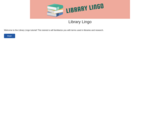
Learn basic research vocabulary. Students will be able to
- Differentiate between types of sources
- Identify scholarly and peer reviewed works
- Identify authors on scholarly works
- Understand the differences between popular and scholarly works

Part 10 of 15.Introduces the Alabama Virutal Library (AVL). Includes outline for an assignment.

Part 11 of 15.Introduces the database EBSCOhost Search from the Alabama Virtual Library (AVL). Includes outlines for an assignment and a quiz.

Part 12 of 15.Introduces the database Gale PowerSearch from the Alabama Virtual Library (AVL). Includes outlines for an assignment and a quiz.

Part 13 of 15.Introduces the database Opposing Viewpoints from the Alabama Virtual Library (AVL). Includes outlines for an assignment and a quiz.